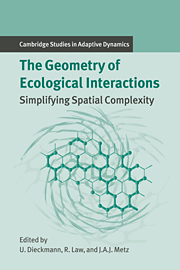Book contents
- Frontmatter
- Contents
- Contributing Authors
- 1 Introduction
- Part A Empirical and Statistical Background: A Plant Ecological Perspective
- Part B When the Mean-field Approximation Breaks Down
- Part C Simplifying Spatial Complexity: Examples
- Introduction to Part C
- 12 Spatial Scales and Low-dimensional Deterministic Dynamics
- 13 Lattice Models and Pair Approximation in Ecology
- 14 Moment Approximations of Individual-based Models
- 15 Evolutionary Dynamics in Spatial Host–Parasite Systems
- 16 Foci, Small and Large: A Specific Class of Biological Invasion
- 17 Wave Patterns in Spatial Games and the Evolution of Cooperation
- Part D Simplifying Spatial Complexity: Techniques
- References
- Index
- International Institute for Applied Systems Analysis
14 - Moment Approximations of Individual-based Models
Published online by Cambridge University Press: 14 January 2010
- Frontmatter
- Contents
- Contributing Authors
- 1 Introduction
- Part A Empirical and Statistical Background: A Plant Ecological Perspective
- Part B When the Mean-field Approximation Breaks Down
- Part C Simplifying Spatial Complexity: Examples
- Introduction to Part C
- 12 Spatial Scales and Low-dimensional Deterministic Dynamics
- 13 Lattice Models and Pair Approximation in Ecology
- 14 Moment Approximations of Individual-based Models
- 15 Evolutionary Dynamics in Spatial Host–Parasite Systems
- 16 Foci, Small and Large: A Specific Class of Biological Invasion
- 17 Wave Patterns in Spatial Games and the Evolution of Cooperation
- Part D Simplifying Spatial Complexity: Techniques
- References
- Index
- International Institute for Applied Systems Analysis
Summary
Introduction
This chapter illustrates insights into individual-based spatial models of ecological communities that can be gained from deterministic approximations. To do this we revisit some of the issues raised in Chapter 1 and show how approximations can help to
separate the signal of an ecological stochastic process from intrinsic random variation;
clarify qualitative dependencies that underlie the ecological stochastic process;
determine how ecological stochastic processes depend on their parameters.
The deterministic approximations we use are the dynamics of spatial moments. These are closely related to pair-approximation methods (Matsuda et al. 1992; Harada and Iwasa 1994; see also Chapters 13, 18, and 19), but are constructed in a continuous rather than a discrete space. They also differ from diffusion approximations (see Chapters 16, 17, 22, and 23) in that they deal specifically with both structure at small spatial scales and the discrete nature of individual plants and animals. Moment methods represent a new departure in ecology for understanding the effects of interactions and movements of individuals in small neighborhoods (Bolker and Pacala 1997; Dieckmann et al. 1997; Law and Dieckmann, in press), and we argue that they hold promise for gaining understanding of ecological processes where the mean-field assumption breaks down. Moment methods are particularly helpful for providing insight into dynamics of plant communities, because interactions mostly occur with immediate neighbors (see Chapter 2). The methods also have potential for describing ecological dynamics in certain kinds of structured landscapes (Wiens et al. 1993; Dunning et al. 1995).
- Type
- Chapter
- Information
- The Geometry of Ecological InteractionsSimplifying Spatial Complexity, pp. 252 - 270Publisher: Cambridge University PressPrint publication year: 2000
- 31
- Cited by



